We are always in search of the Big Idea, and ideas are exciting. It’s out-of-the-box thinking, paving the way to innovation. But innovation, apart from being an eye-stopper, is all about the change brought about by it and the disruption caused.
Why is innovation so important? It’s clearly a competitive advantage. Innovations allow organisations to flourish in the long run, moving far ahead of competition. Without innovation, there’s no change, and today, we are totally aware that change is the only constant! The need for innovation is imperative today. Something that President Obama saw clearly when he said, “We need to out-innovate, out-educate, and out-build the rest of the world”.
Succeeding in Innovation
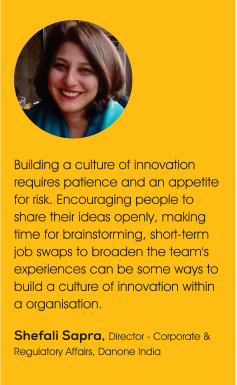 Curiosity keeps leading us down new paths, said Walt Disney. And new paths lead the way to innovation. So, what is the true meaning of innovation?
Curiosity keeps leading us down new paths, said Walt Disney. And new paths lead the way to innovation. So, what is the true meaning of innovation?
“Innovation essentially means staying relevant. It means being able to think of a need before a potential user voices it and finding a solution to meet the need”, opines Nandini Chatterjee, Chief Communications Officer, PwC India.
Innovation for its own sake is neither truly creative nor value-adding. In communication, plain marketing logic that delivers the right message, through the right media mix, to the rightly segmented stakeholders often works better. “You need a roadmap for the journey and a strategy that lays out where and how innovation is going to create value for your organisation,” says Shefali Sapra, Director – Corporate & Regulatory Affairs, Danone India.
Building a Culture of Innovation
Building a culture of innovation today is all the more important than ever before. Today, as in Lewis Carol’s “Through the looking glass”, where the Queen shouted “faster” and “faster”, we have to run fast every day not in order to move ahead, but simply to survive.
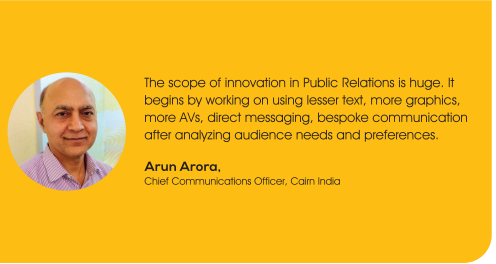 The dynamics of innovation have become crucial for companies today. Not having an appropriate profile as an innovative company can mean losing opportunities or attracting the right talent. Putting it quite simply, “Culture of innovation is built with openness. With tolerance for mistake. With encouragement and positive environment. With desire for Kaizen and maturity to accept ideas”, says Arun Arora, Chief Communications Officer, Cairn India.
The dynamics of innovation have become crucial for companies today. Not having an appropriate profile as an innovative company can mean losing opportunities or attracting the right talent. Putting it quite simply, “Culture of innovation is built with openness. With tolerance for mistake. With encouragement and positive environment. With desire for Kaizen and maturity to accept ideas”, says Arun Arora, Chief Communications Officer, Cairn India.
The team should be exposed to different facets of the business, advises Shefali Sapra. A certain amount of risk-taking is inevitable with Innovation; Teams should be encouraged to take risks, even of it means making mistakes and then learning from them.
Scope of Innovation in Public Relations
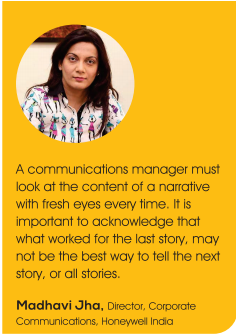 Public Relations is more driven by the richness of message and multimedia content rather than by relationships and media investments alone. It needs to go further down that path so the narrative remains credible and interesting to the consumer. So, it’s significant, emphasies Madhavi Jha, Director, Corporate Communications, Honeywell India. Innovation in communication is embedded in its DNA; it’s like yin and yang, and innovation plays a critical role in making communication relevant to consumers in an engaging manner, points out Shefali Sapra.
Public Relations is more driven by the richness of message and multimedia content rather than by relationships and media investments alone. It needs to go further down that path so the narrative remains credible and interesting to the consumer. So, it’s significant, emphasies Madhavi Jha, Director, Corporate Communications, Honeywell India. Innovation in communication is embedded in its DNA; it’s like yin and yang, and innovation plays a critical role in making communication relevant to consumers in an engaging manner, points out Shefali Sapra.
Ultimately, PR is all about story-telling. So, if you need to engage and then last in public memory, your story should stand apart in all the noise, adds Madhavi Jha. The phenomenon is like how advertising exploded, and ads now struggle to stand out. In PR, the same explosion of content has happened owing significantly to digital media. Earlier, today’s newspaper was tomorrow’s fish-wrapper. Now, early morning’s tweet is stale by late morning.
Innovation in Communication
Where does innovation in communication happen – in content creation, media relations or crisis management? Quite categorically, it’s across the spectrum, points out Madhavi Jha. Business strategy is no longer driven by one mantra. Nor can PR strategy be driven with one thing. The proliferation of media, and proliferation of news consumers and creators alike, mean that content needs to articulate value to the consumer, in a simple, yet fun and engaging way. Media relations will be driven by content that sells, not by influence alone.
Earlier, a traditional PR crisis could be mitigated if you had strong relationships with the media. Now, your stakeholders number millions; most of those relationships are transient and tenuous, often being on social media alone; and every consumer and non-consumer has a voice and a platform to speak at.
It’s in content creation, affirms Arun Arora. Media relations – media rounds being replaced by media roundups, data analytics, trends, real time info sharing. Crisis has witnessed preemptive and preventive communication, with better tools to study impact, capture learning to be better prepared for such eventualities. For Shefali Sapra too, it is happening everywhere. “Emergence of technology has paved the way for innovation in communication. The online media landscape is drastically different from the old days of print. Virality and shareability are important benchmarks in communication today. The more creative the content, the more impact it will deliver,” shares Shefali Sapra.
Innovation and Creativity
Some people may say creativity has nothing to do with innovation – that innovation is a discipline, implying that creativity is not. Alternatively, creativity is also a discipline and a crucial part of the innovation equation. There is no innovation without creativity. The key metric in both creativity and innovation is value creation.
 Innovation is creative thinking, and much more…fundamentally, it goes beyond thinking, to actually implement innovative ideas, clarifies Arun Arora. Creativity adds to, and augments the message and medium, making it more attractive, engaging and lasting in audience memory, but it must be noted that it should be built on sound marketing rationale, says Madhavi Jha. When we talk about innovation, people often expect radical changes or disruption. Nandini Chatterjee, states that innovation is anything that solves a problem or creates new value or provides a great customer experience.
Innovation is creative thinking, and much more…fundamentally, it goes beyond thinking, to actually implement innovative ideas, clarifies Arun Arora. Creativity adds to, and augments the message and medium, making it more attractive, engaging and lasting in audience memory, but it must be noted that it should be built on sound marketing rationale, says Madhavi Jha. When we talk about innovation, people often expect radical changes or disruption. Nandini Chatterjee, states that innovation is anything that solves a problem or creates new value or provides a great customer experience.
What is creativity?
We look for creativity in every sphere of life. Can creativity be learned? There is so much focus on creativity currently, that there is a real possibility that we can easily fall into the trap of confusing creativity with effectiveness, observes Pradeep Wadhwa, Vice President, Corporate Communication, ReNew Power who goes on to say, “Not everything that is creative is effective, therefore in my dictionary effectiveness precedes creativity. There is a definitive positive correlation between the two and in today’s extremely cluttered marketplace with high media fragmentation and the rise of digital/social, creativity is a must to break through the noise and make an impact.”
Within a typical communications set-up, limited resources, working for relatively unknown brands and restricted budgets, it is often seen that creativity comes to the aid of a communications’ professional. To manage difficulties or even take on a challenging goal seamlessly or effortlessly is often the best judge of creativity, notes Swetank Jain, Chief Communications Officer & Chief Customer Officer, Future Group.
Can there be a step-by-step process?
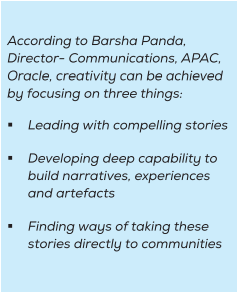
Hiring the Best Creative Talent
Talent is in short supply, as HR consultants point out. And, for PR firms it’s an uphill climb.
One big reason for this is that Public Relations is not seen as a business led by creators of stories. The spotlight is rarely on content creators and the eco system of content creation, asserts Barsha Panda. Swetank Jain puts forth his theory: “For a brand or organisation to create an impact through effective communication, it needs to work on two levels – Wisdom and Energy.”
Traditionally, the common practice was to involve a PR firm only in the second leg that involves execution or energy. Companies, who hire firms, usually hire them for additional manpower only to execute their PR strategy, even while they pay them for both – Wisdom and Energy. This is because PR firms are perceived to be good in operations. Concurrently PR firms themselves, for long, have positioned themselves as a brilliant operations arm, where corporates have reserved the wisdom bit and the role of designing creative strategy for themselves. It is this compartmentalised practice and perception combo by companies and PR firms that has discouraged creative talent to join PR firms, since the ‘best creative talent’ doesn’t see themselves taking on creative work in traditional PR firms. All these make it challenging for PR firms to hire the best creative talaent.
In this scenario, the onus for a paradigm shit lies greatly on the company or client. While the change has to start from the organisation’s side, PR firms and professionals too need to proactively seek work that involves wisdom and a creative contribution at the strategy level. The bottomline remains – we need to look at PR firms as communication partners instead of hired help. Involving them in the decision-making process will encourage them to deliver greater creative impact on the brand’s customers and take more responsibility of the outcome.
Presenting another angle is Pradeep Wadhwa who says, ” PR firms traditionally were not known to be creative, hence are not seen as the first choice by the best creative talent. Also, even if they are able to hire them, managing and nurturing creative talent requires a different mind-set and culture than what PR firms are used to.”

How can PR firms lead in the creative arena?
PR firms are ramping up their role. They are now coming up with unconventional solutions and unique ways of connecting with their audience. They are proving their worth as strategic partners where they also provide creative solutions. There has also been a rise of niche PR firms or even niche segments or departments within PR consultancies that are actively working on providing creative solutions to the clients, rather than focusing solely on the execution, elaborates Swetank Jain. But, this is just the beginning. There is much more that needs to happen. This includes a greater acceptability and inclusion of PR firms by the clients or corporates in the strategy-building stage.

Some of the PR firms are firmly focused on building up their social media strength. In doing that, any smart team will sooner or later reach the conclusion that social media is about content creation and creators. At that point, I find them investing in content developers. On the brand side, we are focusing on the immersion of communications teams into the story-telling exercise, discloses Barsha Panda. For example, with Technology PR, their starting point of story-telling is not where the technical talk ends, but it is at the effort put into understanding the actual context of why this development is a real story.
Innovation and Creativity – The Road Ahead
“The digital medium has taken the world of communication by storm, as it holds great reach and power to impact its audience, even while the conventional media continues to thrive”, observes Swetank Jain. While the choice of the right medium is an important component, a lot of emphasis is also being laid on the content that is being conveyed. The type of content that we disseminate to the media or customers is gaining more importance. Though, it is the combination of the right content with the right medium that’s going to spell innovation and creativity.
Both clients and consultancies understand the importance of innovation and creativity – the need is established, says Pradeep Wadhwa. We should make sure that in this race, the basics are not compromised (who our stakeholders are, what are they driven by, what are our key messages, which is the best channel to reach them, how will we measure success) else it will be just art and will not achieve business goals.
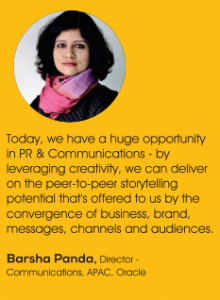
Barsha Panda sums it up by saying, “With social media and new technologies redefining what we can do, I think the bar for innovation and creativity keeps going higher across PR and advertising. I am sure we’d love to see and even create some fundamental shifts in storytelling in 2018. And whether such a shift takes place this year or not, it will definitely surprise and delight us in the near future.”
The shifts in the changing landscape have ushered in major changes in PR. Is it creativity now that matters more than ever? Or who is more innovative? That actually decides whether you have a lead or not. With pushing competition, diversity dialogues already in sight, the road ahead will be – thinking out-of-the-box! So, what’s your Big Idea?






Be the first to comment on "What inspires out-of-the-box thinking?"